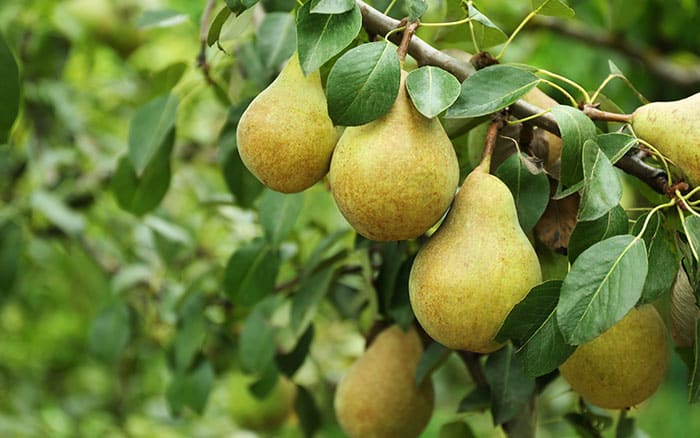Common in fruit bowls all over the UK, the pear is a popular fruit with its soft texture. They even used to be called ‘butter fruit’ referring to its soft butter-like texture. So, find out how to grow your own pears at home.
On a visit to Worcester, Queen Elizabeth I saw a pear tree that she thought was beautiful. It impressed her so much that she made the pear the emblem of the city.
Perfect pairs
The ideal spot for a pear tree is a sunny, sheltered site, that is away from any frost pockets.
Pear trees are sold in two forms, either bare-root or containerised. Bare root is when they are sold with the roots exposed and ready to plant.
These types should be planted out between late autumn and early spring, whereas containerised plants can be planted up at any time of the year, but winter is best.

Pear trees aren’t grown in their own roots, instead the top of the tree is grafted onto different rootstock, which controls the size of the tree. So, pears can be grown in pots, but when doing this, ensure that they are on a dwarf rootstock.
Like apples, pears might need a pollinating partner from the same group. So, be sure to check, because it might be best to grow your pears in pairs. Although, you can get self-fertile types too.
When planting, dig a hole that is the depth of the roots and up to three times the diameter of the roots. When digging, break up the sides and base of the whole too so it’s not hard.
Then place the plant in the hole and add all of the soil, firming into place by stepping on it to ensure there aren’t any air pockets in the soil.
Take care

During dry spells and when the fruit is starting to swell, water well. This is really important when growing in containers too.
The best time to prune pear trees is between November and March, when the plant is dormant and there are no leaves on it.
When pruning, focus on the old wood, and take this out rather then young wood which is where the fruit will grow.
It’s ideal to take off around 10-20% of the overall canopy per year because pruning hard can lead to growth of large numbers of water-shoots.
Pick your pears
Pears will be ready for picking around August to October. Harvest the pears just before they are fully ripened, when they feel firm and have a slight colour change on their skin.
Early varieties can be taste tested for their sweet flavour and firm texture. Late varieties can be lifted and twisted to be picked, and when ready they will come away easily.

Pears are picked before ripening because they tend to ripen better off the tree. Therefore, they’ll store well for a few months.
Pears are a rich source of many important minerals. For instance, they are a great source of copper than plays a role in immunity and nerve function, as well as potassium which aids muscle contractions and heart function.
What’s more, they are an excellent source of fibre – both soluble and insoluble – which is essential for our digestive health.

Leave A Comment